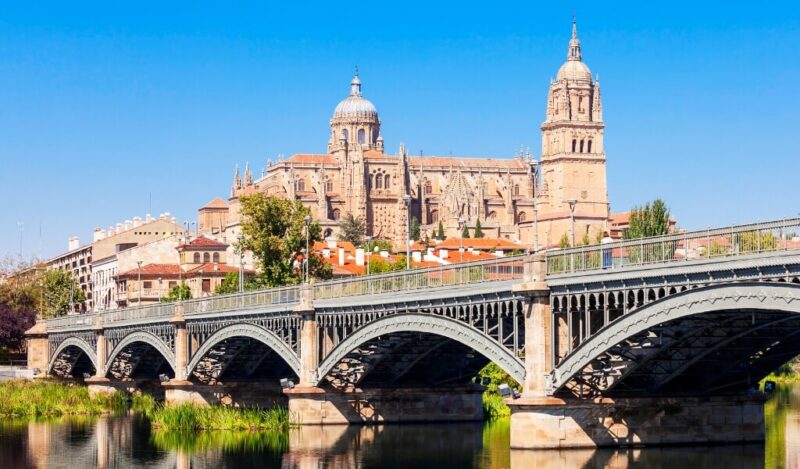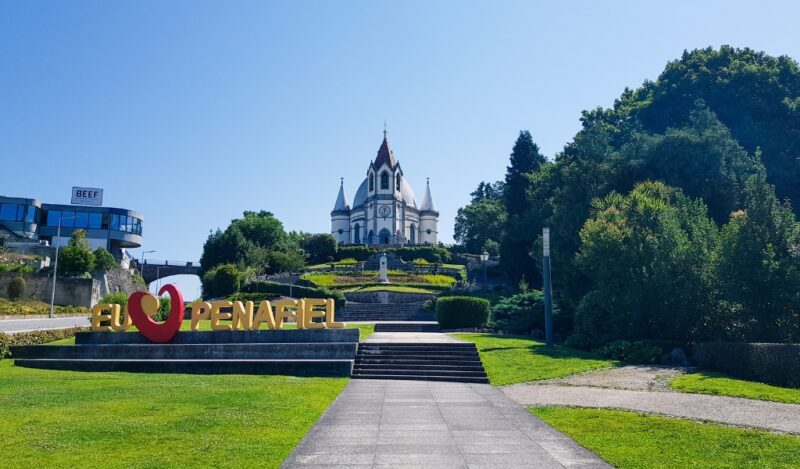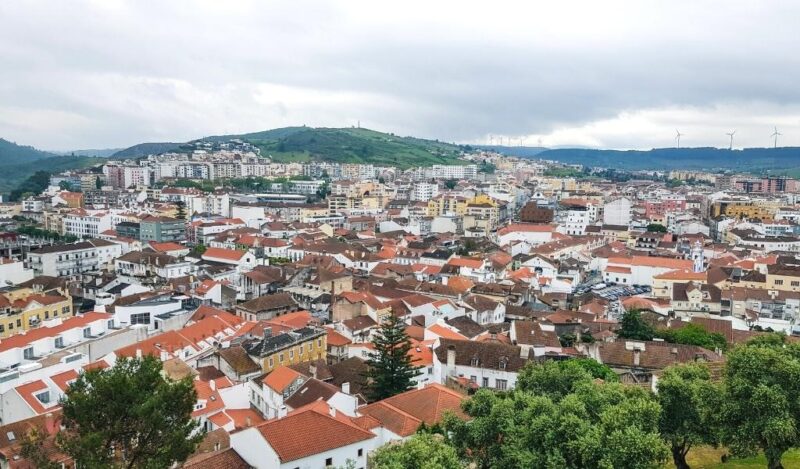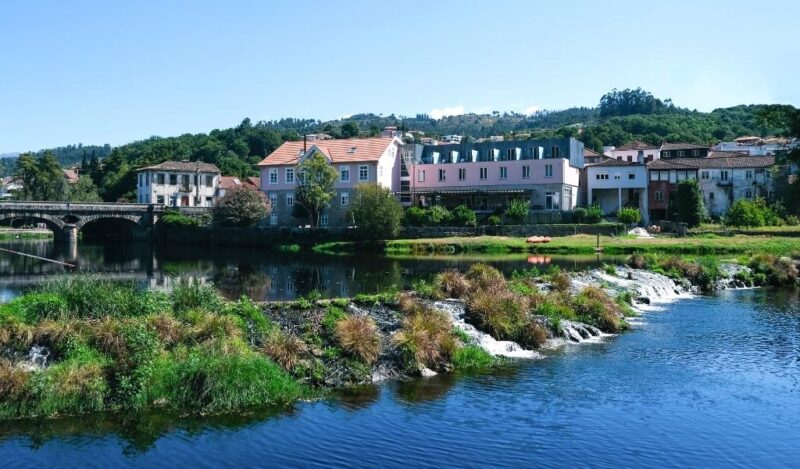In 1890, businessman Eusebi Güell decided to build an industrial colony for his workers in the municipality of Santa Coloma de Cervelló, just over 15 km from the center of Barcelona. Nicknamed Colònia Güell, this textile complex had not only accommodation for the factory workers, but also several public buildings.
One of them is the Crypt of Colònia Güell, a masterpiece of Catalan modernist architecture, which has been a UNESCO World Heritage Site since 2005. This unfinished church was designed by Antoni Gaudí and became, together with Palau Güell and Park Güell, one of the many monuments the artist designed for Eusebi Güell!
So, do you want to know more about 1 Day In Colònia Güell: The Perfect Colònia Güell Itinerary? Keep reading!
This post may contain affiliate links, meaning I earn a small commission if you make a purchase, at no additional cost to you. Please read my disclosure & privacy policy for more information.
No time to read now? Pin it for later!


- Brief History of Colònia Güell
- Visiting Colònia Güell
- Colònia Güell Itinerary
- Antics Cellers de la Cooperativa
- Antiga Cooperativa de Consum
- Antiga Casa del Secretari
- Centre de Sant Lluís
- Escola & Casa del Mestre
- Ca l'Espinal
- Antiga Casa del Metge
- Ateneo Unió & Teatre Fontova
- Dipòsit d'Aigua
- Can Soler de la Torre & Capella de la Mare de Déu dels Dolors
- Recinte Industrial
- Ca l'Ordal
- Església (Cripta)
- Casa Parroquial
- Can Julià de la Muntanya
- Torre Salbana
- Map of the Colònia Güell Itinerary
- More Posts about Spain
- More Posts about Travel Itineraries
- What Photography Gear Do I Use?
Brief History of Colònia Güell
The history of Colònia Güell dates back to 1890, when the Catalan industrialist and politician Eusebi Güell i Bacigalupi owned property in Santa Coloma de Cervelló: the Can Soler de la Torre. Now, influenced by the social conflicts that were going on in Barcelona at that time, the businessman decided to transfer his fabric factory from the busy city center to that quiet suburb.

In just a few years, Colònia Güell went from a simple textile complex to an authentic working-class city, with the construction of numerous public infrastructures of a social, cultural, and religious nature. In addition, Eusebi Güell commissioned renowned architects – such as Antoni Gaudí i Cornet, Francesc Berenguer i Mestres, Joan Rubió i Bellver, and Francesc Berenguer i Bellvehí – to embody the new Catalan modernist style in these new buildings.
Visiting Colònia Güell
Despite having chosen to create a Colònia Güell itinerary for a whole day, I think you can visit all the points of interest in the morning or afternoon – especially since many can only be seen from the outside. Still, remember that Colònia Güell is 25 minutes from Barcelona, so plan your trip in advance.
To get to Colònia Güell, take the S3, S4, S8, or S9 line from the Ferrocarriles de la Generalitat de Catalunya (FGC), in Plaça d’Espanya. This train station is also served by lines L1, L3, and L8 of the Transports Metropolitanos de Barcelona (TMB), in case you need to travel from another part of the city.
WARNING: This train ticket costs €2.40 and is not included in the Barcelona Card (unlike the metro ticket)!
Colònia Güell Itinerary
Antics Cellers de la Cooperativa
This Colònia Güell itinerary begins at the Former Cellars of the Cooperative (in Catalan, Antics Cellers de la Cooperativa).
Constructed in 1920 to complement the Former Consumption Cooperative, this building has a rectangular plan with two floors.

The ground floor housed the cellars, coal mines, and warehouses, while the upper floor was intended for housing. Today, the space is mainly used for public services and temporary exhibitions.
You can find the Former Cellars of the Cooperative on Carrer Claudi Güell, right in front of the Former Consumption Cooperative.
Antiga Cooperativa de Consum
The Former Consumption Cooperative (in Catalan, Old Consumer Cooperative) is a mandatory place on this Colònia Güell itinerary, as this is where the Colònia Güell Interpretation Center (ie, the Tourist Office) is located. In other words, this is where you have to buy a ticket to enter the Crypt of Colònia Güell!

Situated between Carrer Claudi Güell and Carrer Mossèn Frederic Martí, the building was designed by Francesc Berenguer i Mestres and Joan Rubió i Bellver in 1900. The ground floor functioned as a warehouse and food retail space, while the first floor was a social center.
Antiga Casa del Secretari
The Former Secretary’s House (in Catalan, Antiga Casa del Secretari) is located between Carrer Claudi Güell and Carrer Aranyó.
Interestingly, the name is due to the fact that this was the home of the secretary of the Municipality of Santa Coloma de Cervelló, who lived here for many years.

After he moved, the Old Secretary’s House served as the municipal office but kept its popular designation. And these days, it’s the Medical Office of Colònia Güell.
My favorite decorative details of this building are the lozenges with the Cross of Saint George and the four stripes of the coat of arms of Catalonia, present on the frieze and on the balcony of the first floor!
Centre de Sant Lluís
If you go through Carrer Aranyó, you’ll pass by a former convent of nuns, which was built between 1891 and 1892 and is now a civic center.
But the main attraction of this street is Saint Louis’ Center (in Catalan, Center de Sant Lluís), the cultural center of Colònia Güell. It’s also known as Saint Louis’ Municipal Center.

Designed by Francesc Berenguer i Bellvehí between 1915 and 1918, this modernist building started out as a school for girls and the headquarters of the Patronat Obrer de la Sagrada Família.
After the Spanish Civil War (1936-39), the space began to be used as a theater and library and currently houses the Joaquim Folguera Popular Library.
Escola & Casa del Mestre
In my opinion, the School & Schoolmaster’s House (in Catalan, Escola & Casa del Mestre) are two of the most fascinating points of interest on this Colònia Güell itinerary. To catch a glimpse of them, you must first cross Plaça Joan Güell and then walk (or rather, climb) Carrer Barrau to the end. And did you know that this primary school was in operation until 2011?

Designed by Francesc Berenguer i Mestres and Francesc Berenguer i Bellvehi (father and son), these two modernist buildings date back to 1911. According to historical records, the school was free for the workers’ children, even though the education was different for boys and girls. For example, female education focused on manual and domestic work and was in charge of the nuns of the convent.
Ca l’Espinal
Ca l’Espinal is the first of a series of private houses, which I decided to include in this Colònia Güell itinerary.
An obvious example of Catalan modernism, it was designed by Joan Rubió i Bellver in 1900 and has this same year engraved on the entrance slabs.

With a square floor plan, Ca l’Espinal is located between Carrer Monturiol and Carrer Malvehy, a markedly residential area of Colònia Güell.
Considered one of the masterpieces of this working-class city, this house stands out for its circular balcony inspired by medieval turrets and for its windows in the shape of elongated hexagons.
Antiga Casa del Metge
The Former Doctor’s House (in Catalan, Antiga Casa del Metge) is right next to Ca l’Espinal, on Carrer Malvehy.
Erected in 1911, the architect responsible is unknown, although the style fits in Catalan modernism, similar to the neighboring Ca l’Espinal.

The presence of a doctor was absolutely indispensable in an industrial colony of this time and, therefore, Colònia Güell was no exception.
However, there’s another mystery associated with this construction: no one really knows when it stopped being the Former Doctor’s House and became just another private house!
Ateneo Unió & Teatre Fontova
Let’s return to Plaça Joan Güell, this time to visit two cultural spaces: the Union Athenaeum and the Fontova Theater (in Catalan, Ateneo Unió & Teatre Fontova).
Their construction began in 1892 and was only completed in 1899. And once again, the architect is not known!

The first of the two to open was the Fontova Theatre, whose name is self-explanatory. Together with the Union Athenaeum, they were the first recreational institutions in Colònia Güell.
Installed next to each other, the Union Athenaeum & Fontova Theater consisted of a lounge café, billiards, library, and theater. And today, they continue to be a bar restaurant and theater!
Don’t forget to admire the “Monument to Eusebi Güell”, the statue that adorns the center of Plaça Joan Güell!
Dipòsit d’Aigua
This Colònia Güell itinerary continues towards the Water Deposit (in Catalan, Dipòsit d’Aigua), located on Camí de Can Ros.

It’s not known who was the architect or engineer responsible, but it’s known that it has existed since 1895. In fact, both the factory and the industrial colony were served by very efficient water distribution and storage network.
This Water Deposit was one of the many tanks, wells, and cisterns scattered around the textile complex, which contributed to the self-sustainability of the working-class city. With a polygonal base and a brick dome, this cylindrical structure supplied the director’s house and was located in the garden of his property, within the walls of the factory.
Can Soler de la Torre & Capella de la Mare de Déu dels Dolors
As I mentioned earlier, Can Soler de la Torre already belonged to Eusebi Güell before he decided to create Colònia Güell.
The private property was acquired by Joan Güell i Ferrer (his father) in 1860, together with the surrounding farmland. And since the building is from the 17th century, the architect Francesc Berenguer i Mestres was asked to renovate it and transform it into the family’s temporary residence.

Among the most characteristic elements of this manor house are the two sundials on the main façade and the vaulted entrance door.
Attached to Can Soler de la Torre, there’s a small chapel dedicated to Our Lady of Sorrows. Before the construction of the Crypt of Colònia Güell, it was here that the workers worshiped.
Recinte Industrial
The Colònia Güell Industrial Enclosure (in Catalan, Recinte Industrial Colònia Güell) is, of course, the heart of this working-class city and the reason it exists.
Occupying a large part of the 160 hectares of Colònia Güell, this factory was distinguished from the others at that time (and from that region) for working with steam energy instead of hydraulic energy.

The Colònia Güell Industrial Enclosure specialized in manufacturing fabrics, especially velvets made from cotton from America.
The textile complex consisted of a walled enclosure, where a set of buildings carried out different activities: spinning, weaving, dyeing, washing, drying, cutting, etc.
Ca l’Ordal
It’s likely that you’ve already passed by Ca l’Ordal at the beginning of this Colònia Güell itinerary, not least because it’s the first building in the residential area of the working-class city. Designed by Joan Rubió i Bellver around 1894, this private house has a very different detail: it was inhabited by three families!

Despite looking like a large manor house at first glance, Ca l’Ordal is actually a group of three semi-detached houses with a basement, ground floor, first floor, and attic. As far as is known, the residents were farmers who tended the fields, with some family members working in the factory.
Església (Cripta)
And here we arrive to the main attraction of this Colònia Güell itinerary: the Gaudí Church or Crypt of Colònia Güell (in Catalan, Esglégia Gaudí or Cripta de la Colònia Güell), Antoni Gaudí’s first unfinished church (the second and most famous is the Basilica of the Sagrada Familia)!
Antoni Gaudí started the project in 1898, although construction didn’t start until a decade later. The original plan was to build a church with two naves (lower and upper), several towers, and a central dome 40 meters high, but the architect abandoned the work in 1914 after the Güell family cut funding.


Consecrated the following year and declared a UNESCO World Heritage Site in 2005, the Crypt of Colònia Güell is very relevant in the history of Catalan modernism, as it served as a “guinea pig” to Antoni Gaudí. For example, the architectural solutions implemented in the Basilica of the Sagrada Familia were first studied and tested here!
Pay special attention to the entrance porch and portal, with a “forest” of inclined columns made of basalt and brick; the colorful stained glass windows inside, which represent crosses formed by “flower petals” or “butterfly wings”; the church benches, designed by Antoni Gaudí himself; and all the Christian iconography that decorates the space: crosses, monograms, fish, the Greek letters Alpha and Omega, etc.


The Crypt of Colònia Güell is open every day of the year (except on January 1st and 6th, December 25th and 26th), from 10 am to 3 pm. It’s important to mention that this is the only monument in Colònia Güell that requires a paid entrance. The ticket costs €9.5 (adults) or €7.5 (students, young people, and over 65) and includes an audio guide.
TIP: If you buy the Barcelona Card, you’re entitled to a special ticket priced at €7.60!
Casa Parroquial
The Parish House (in Catalan, Casa Parroquial) is located behind the Crypt of Colònia Güell and features the figure of the Sacred Heart of Jesus on its main façade, more precisely in the center of the upper floor.
Its foundation dates back to 1917 and it’s known to have served as a parish house since then. The building has a single ground floor plus an attic, besides a small garden all around.

On the main façade, it’s also possible to observe the cladding with irregular stone slabs, as well as the semicircular brick arches, which flank the ground floor windows.
Its architect was Francesc Berenguer i Bellvehi.
Can Julià de la Muntanya
The last private house on this Colònia Güell itinerary is an old country house from the 17th century, surrounded by small dwellings.
Nicknamed Can Julià de la Muntanya, this farm is located in the farthest part of the Colònia Güell Industrial Enclosure, almost on the edge of the working-class city.

During the development of Colònia Güell, Can Julià de la Muntanya assumed different roles. First, it welcomed the congregation of nuns, who later moved to the Carmelite convent already mentioned in this itinerary.
Then it became the temporary home for workers who had just arrived in the industrial colony. And finally, it also served as a laundry, thanks to a water mine that supplied the property.
Torre Salbana
Did you know that the last point of interest on this Colònia Güell itinerary is also the oldest? Yes, the Salbana Tower (in Catalan, Torre Salbana) was constructed in the 11th century!
Also known as Torre d’Eles, this medieval tower consists of a central structure – reminiscent of a palace and completely in ruins – and a round tower, almost 15 meters high and 4 meters in diameter.

As was customary in the Middle Ages, these towers guarded and defended the manor houses (and their lands) and the Salbana Tower is a clear example of this.
No one really knows who the owners of this historic building were, but it’s believed that it was the lords of Salbà, who gave it its name.
Map of the Colònia Güell Itinerary
Share this blog post on your social media!
More Posts about Spain
7 Best Museums In Barcelona (That You Should Visit This Year)
World Heritage In Castile And León (2024)
Complete Guide To The Works Of Antoni Gaudí
More Posts about Travel Itineraries
1 Day In Penafiel: The Perfect Penafiel Itinerary
1 Day In Torres Vedras: The Perfect Torres Vedras Itinerary
2 Days In Arcos De Valdevez: The Perfect Arcos De Valdevez Itinerary
What Photography Gear Do I Use?
- Camera Body: Fujifilm X-T4 Mirrorless
- Camera Lens: Fujinon XF 18-55 mm F2.8-4 R LM OIS
- Tripod: Manfrotto Compact Action
- Small Tripod: Manfrotto PIXI Mini
- Smartphone Adaptor: Manfrotto PIXI Clamp
- Memory Card: SanDisk 128GB Extreme PRO SDXC






